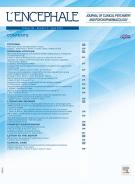Reconnaître les symptômes psychiatriques iatrogènes liés aux antipsychotiques - 28/10/10
 , V.-A. Chouinard c, d, G. Chouinard c, d
, V.-A. Chouinard c, d, G. Chouinard c, d| pages | 8 |
| Iconographies | 0 |
| Vidéos | 0 |
| Autres | 0 |
Résumé |
Notre travail propose une revue des études multicentriques portant sur la prescription des antipsychotiques. Un traitement bien conduit suppose que le clinicien puisse régulièrement réévaluer son indication afin de prescrire la dose minimale efficace. En pratique il est important de bien distinguer les symptômes psychiatriques secondaires au traitement des symptômes causés par l’affection initiale. En effet, les mouvements anormaux persistants (ainsi que les troubles psychiatriques qui leur sont associés) sont un facteur de risque pour les dyskinésies tardives ou pour l’émergence d’une psychose de super sensibilité. Dans cette optique, il est raisonnable d’avancer que la prescription de neuroleptiques conventionnels devrait être totalement limitée en raison de l’importance des effets secondaires qui en résultent. Globalement, l’incidence des mouvements anormaux (en particulier des dyskinésies tardives) diminue mais reste importante. De meilleures habitudes de prescription (doses réduites de psychotropes au long cours, traitement adjuvant par anticonvulsivants…) devrait permettre de progresser encore dans la tolérance des thérapeutiques antipsychotiques prescrites.
Le texte complet de cet article est disponible en PDF.Summary |
Introduction |
This article proposes a review of atypical multicentre studies for drug-induced movement disorders (and related psychiatric symptoms) and supersensitivity psychosis. A well-conducted antipsychotic treatment consists of regular attempts to reduce the dose by finding the minimal therapeutic dose. To achieve optimal antipsychotic treatment, it is important to distinguish psychiatric symptoms associated with drug-induced movement disorder(s) (DIMD) or supersensitivity psychosis from true relapse.
Literature findings |
Persistent DIMD have been found to be a predictor of supersensitivity psychosis or tardive dyskinesia (DT). DIMD-associated psychiatric symptoms can be classified into three types: directly induced by DIMD; resulting from confounding DIMD with psychiatric symptoms; and supersensitivity symptoms associated with DIMD. Without this distinction, the beneficial effects of antipsychotics are masked by emergent DIMD psychiatric symptoms (as was confounded in the CATIE study).
Discussion |
A constant decline in the prevalence of TD (hyperkinetic, involuntary and purposeless movement disorder) has been observed since the introduction of atypical antipsychotics. The neurotoxic effects of classical antipsychotics are well documented and their discontinuation is required. However, the risk of TD still exits with atypical antipsychotics and continued surveillance of emerging cases is very important for clinicians. Moreover, a regular evaluation of DIMD and associated psychiatric symptoms is crucial. It is important to underline the fact that DIMD persists with antipsychotics, with significantly higher total PANSS scores than in patients without DIMD.
Conclusion |
Supersensitivity psychosis is a drug-induced psychotic relapse (6 weeks following the decrease or withdrawal of an antipsychotic). Discontinuation syndromes can produce psychiatric symptoms (and be confounded with true relapse), but can be improved more quickly after reintroduction of treatment. Interestingly, various data suggest that lower doses of antipsychotics could prevent such symptoms. Anticonvulsants can be efficient adjuvants in the treatment of psychosis. In the United States, many patients received valproate or gabapentin treatment. These adjuvants, by antikindling effect, can facilitate minimal maintenance drug treatment and be efficient for anxiety. Resistant schizophrenia can be related to supersensitivity psychosis; gabapentin and lamotrigine are effective in this case.
Le texte complet de cet article est disponible en PDF.Mots clés : Anticonvulsivants, Antipsychotiques, Étude CATIE, Psychose de supersensibilité, Syndrome de sevrage, Symptômes psychiatriques iatrogéniques
Keywords : Anticonvulsants, Antipsychotics, CATIE study, Supersensitivity psychosis, Withdrawal discontinuation syndrome, Iatrogenic psychiatric-like symptoms
Plan
Vol 36 - N° 5
P. 417-424 - octobre 2010 Retour au numéroBienvenue sur EM-consulte, la référence des professionnels de santé.
L’accès au texte intégral de cet article nécessite un abonnement.
Bienvenue sur EM-consulte, la référence des professionnels de santé.
L’achat d’article à l’unité est indisponible à l’heure actuelle.
Déjà abonné à cette revue ?

